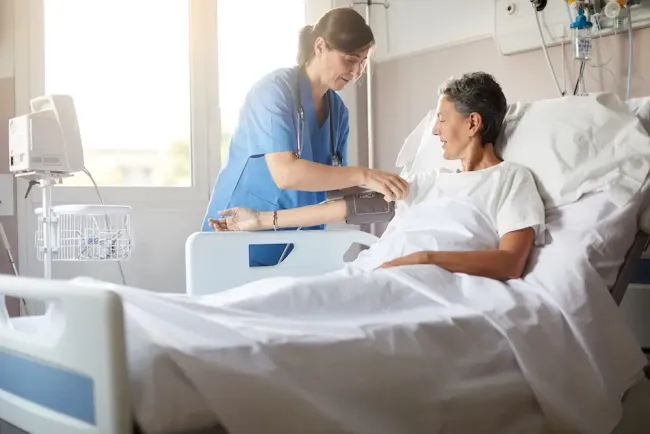What is the HCAHPS survey?
The Hospital Consumer Assessment of Healthcare Providers and Systems (HCAHPS) is a standardized 32-question survey designed to capture hospital care experiences and patients’ voices.
It’s used to measure how consistently hospitals deliver the kinds of interactions and behaviors that form critical aspects of care – like clear communication with nurses and doctors, hospital staff responsiveness and how prepared patients feel to navigate recovery after discharge.
Any US hospital that falls under the Hospital Inpatient Prospective Payment Systems (IPPS) payment system is required to complete HCAHPS survey administration in order to receive full reimbursement via the Annual Payment Update. Each must collect at least 300 completed surveys a year.
The survey is overseen by the Centers for Medicare & Medicaid Services (CMS) and is a key part of the Value-Based Purchasing (VBP) program, which ties hospital reimbursement to both hospital care outcomes and patient experience.
It’s the first publicly reported survey of its kind at the national level, endorsed by federal agencies, consumer groups and professional associations.
Why are HCAHPS scores important?
HCAHPS survey results are used to generate HCAHPS scores. These scores matter because they give patients a voice – and those voices carry weight.
HCAHPS data is made public on Medicare’s Care Compare site, giving patients and families a transparent way to make valid comparisons between hospitals – and giving healthcare providers a clear understanding of patient experience and where they can improve.
They also affect a hospital’s bottom line. Through the Centers for Medicare & Medicaid Services (CMS) Value-Based Purchasing (VBP) program, part of a hospital’s reimbursement is tied to its HCAHPS performance – and therefore the quality of care provided, not just the quantity of it. The VBP Program withholds 2% of a hospital’s Medicare payments and will give back a portion of that sum back based on the hospital’s performance against quality and experience metrics.
But perhaps most importantly, the HCAHPS survey allows patients to share their perceptions of experience. It highlights the human side of healthcare which often makes the difference between a good versus an excellent care experience.
Hospitals that treat HCAHPS as more than a compliance exercise are often the ones that build stronger trust with their patients and communities.
HCAHPS vs. CAHPS
The Consumer Assessment of Healthcare Providers and Systems (CAHPS) surveys are a data collection methodology designed to measure patient experiences across different settings, from outpatient clinics to health plans.
HCAHPS – also known as the CAHPS hospital survey – is one specific survey within that umbrella, focused exclusively on patients’ experiences after an acute care hospital stay. It captures feedback from recently discharged inpatients, making it the standard for benchmarking hospital quality and consistency of care.

HCAHPS key measures
The HCAHPS survey groups its 32 survey items into various key measures, also known as domains.
These measures are designed to capture the consistency of core interactions that define a patient’s hospital experience – from communication and responsiveness, to the environment of care and transitions after discharge.
Each measure reflects a theme that matters to patients and directly influences overall hospital ratings and reimbursement. The aim is to provide objective and meaningful comparisons across hospitals, and consistently measure patients’ perceptions through the data collected.
As of 2025, the HCAHPS survey has seven domains and four single item sub-measures.
HCAHPS domains
Doctor Communication
Patients are asked if doctors treated them with courtesy and respect, listened carefully and explained things in ways they could understand. This measure highlights how consistently physicians connect with patients on a human level.
Nurse Communication
Nursing care is at the heart of the patient experience. Patients report how often nurses showed respect, listened attentively and explained treatments or instructions clearly; the answer scale is “never”, “sometimes”, “usually” and “always”.
Strong nurse communication is consistently one of the biggest drivers of overall hospital ratings.
Restfulness of Hospital Environment
HCAHPS survey items see patients asked about the quietness of the hospital environment, their ability to get the rest they need, and if doctors and nurses helped them get that rest.
As rest is central to the recovery process – and noise can significantly disrupt it – this is a key measure of the healing environment.
Care Coordination
This measure focuses on how well staff prepared patients for managing their health after discharge, including whether preferences were considered and whether responsibilities were explained.
Seamless care coordination is an important measure as smooth care transitions reduce readmissions and improve patient outcomes.
Responsiveness
This measure looks at how quickly staff responded when patients needed help – such as answering call buttons or assisting with basic needs. Strong responsiveness scores signal attentiveness, trust, safety and reliability of care.
Communication about Medicines
Patients are asked if staff explained new medications, their purpose and potential side effects. Clear conversations about medicine are critical for safety and patient confidence in care.
Discharge Information
This measure is focused on the continuity of care beyond the hospital stay. Patients report if they received written instructions about symptoms to watch for and guidance on what to do after leaving the hospital.
HCAHPS single item sub-measures
Cleanliness
This measure investigates how consistently hospitals maintain hygiene standards, with clean rooms and bathrooms essential for comfort and safety.
Information about Symptoms
This measure asks whether patients received clear guidance on what symptoms or health problems to look out for after leaving the hospital.
Timely, complete and accessible information about symptoms – including what to expect and when to seek help – strengthens care coordination and reduces the risk of complications or readmissions.
Overall Rating
The survey asks patients to rate the patient’s specific stay from 0 (worst) to 10 (best).
By asking if the patient was satisfied with their experience, this question is more transactional in nature than the focus of “Likelihood to Recommend”.
Likelihood to Recommend
Finally, patients are asked if they would recommend the hospital to friends and family. This measure captures overall trust and loyalty, distilling the entire experience into a simple “yes” or “no.”
Importantly, “Likelihood to Recommend” differs from “Overall Rating” as it takes emotion into account. It determines if a patient feels strongly enough about their experience that they would recommend it.
Benefits of the HCAHPS survey
The HCAHPS survey is more than a regulatory requirement – it’s a tool for learning, public accountability and improvement. By capturing patients’ perspectives in a standardized way, hospitals gain insights into where they’re excelling and where they need to improve.
Listening to patients at scale
HCAHPS provides a consistent, nationally recognized way to hear from patients after a hospital stay. Because the survey asks the same questions across hospitals, providers can benchmark performance, identify gaps and focus improvement efforts on the areas patients value most – like communication, responsiveness and discharge planning.
Driving quality improvement
The survey highlights the consistency of behaviors and processes known to impact experience.
When hospitals act on HCAHPS insights, they often see better communication, smoother care transitions and a more consistent service. These improvements not only raise scores but also strengthen trust and, most importantly, improve outcomes for patients.
Linking experience to reimbursement
Under the CMS Value-Based Purchasing program, a portion of hospital payments is tied to HCAHPS results. Stronger performance sees hospitals receive a greater share of the 2% sum withheld by the VBP Program, while poorer scores see a reduced share returned.
This reinforces the idea that excellent patient experiences aren’t just good practice – they’re good business.
Promoting transparency and accountability
Because HCAHPS scores are publicly reported on Medicare’s Care Compare website, hospitals are held accountable to both regulators and the communities they serve. Public reporting creates transparency that builds trust, and allows patients and families to make informed choices about where to seek care.
The role of HCAHPS in patient experience
HCAHPS plays a vital role in capturing the consistency of patient experiences. It asks how consistently certain interactions happened – how often did nurses listen, how often did doctors explain things in a way you could understand, and how often did staff work together to care for you.
But it doesn’t always reveal the quality of those interactions. For example, a patient may report that a nurse explained their medication, but HCAHPS won’t capture whether the explanation was rushed, empathetic or easy to understand.
To deliver truly exceptional care, hospitals need to go beyond knowing if something happened to also understand how well it was experienced. This is where modern Site of Care (SOC) surveys and real-time feedback tools offered by Qualtrics come in. These solutions explore the quality of behaviors and interactions – whether patients felt respected, whether communication reduced anxiety and whether support met their unique needs.
By combining HCAHPS with broader patient experience listening programs, healthcare organizations can move from compliance to continuous improvement. Instead of just meeting the standard, providers can identify opportunities to act, elevate patient trust and improve outcomes across the entire journey.
How to improve your HCAHPS score
Improving HCAHPS scores requires more than just meeting the baseline of survey expectations – it’s about delivering consistent and high-quality experiences across every touchpoint. Hospitals that focus on both dimensions are the ones that see lasting improvements in scores, outcomes and patient trust.
Strengthen communication with staff
Patients want to feel heard and understood. The importance of coaching doctors, nurses and support staff to use plain language, check for understanding and show empathy can’t be understated.
It’s not enough to simply explain a treatment – patients need to leave the conversation feeling confident in what was said.
Improve responsiveness
Responsiveness is one of the clearest signals to patients that their needs matter. Which is why timely responses to call buttons, requests for help or questions make a real difference.
It’s important to build processes that reduce wait times, enhance care coordination and ensure staff are available when patients need them.
Focus on coordination and discharge
Smooth transitions out of the hospital reduce readmissions and improve satisfaction. Make sure discharge instructions are not just handed out but explained in ways that patients and families can understand. Reinforce this with calls, mail follow up or other resources to support recovery at home or the next level of care.
Enhance the hospital environment
Prioritizing a healing environment – cleanliness, reduced noise at night, restfulness – reinforces patient trust in the safety and professionalism of the hospital.
Combine consistency with quality
Meeting HCAHPS requirements ensures consistency, but true improvement comes from layering on quality. Staff may always provide explanations, but did they do it in a way that felt clear, respectful and reassuring? That’s the difference between compliance and excellence.
Pairing HCAHPS with modern feedback tools like Qualtrics® Site of Care surveys helps hospitals capture this richer view and continuously refine the patient experience.
Unlock more from HCAHPS with Qualtrics
Improving HCAHPS performance requires more than checking boxes – it means understanding patient feedback in context, acting on it and adapting to changes in how the survey is administered. That’s where the Qualtrics Healthcare Experience Management Platform® comes in.
As a CMS-approved vendor, Qualtrics enables hospitals to run HCAHPS surveys while integrating them with broader patient experience programs.
Our platform brings regulatory survey data together with real-time feedback – giving healthcare providers a complete view of not just whether interactions occurred, but how well they were experienced. This helps hospitals pinpoint gaps, act quickly, and improve both scores and care deliveryWith recent updates to HCAHPS – including new survey methods and expanded domains – keeping pace is essential. Our latest resource, HCAHPS Updates: Unlock New Insights into Patient Experience, explains how these changes impact results and offers strategies to adapt.



